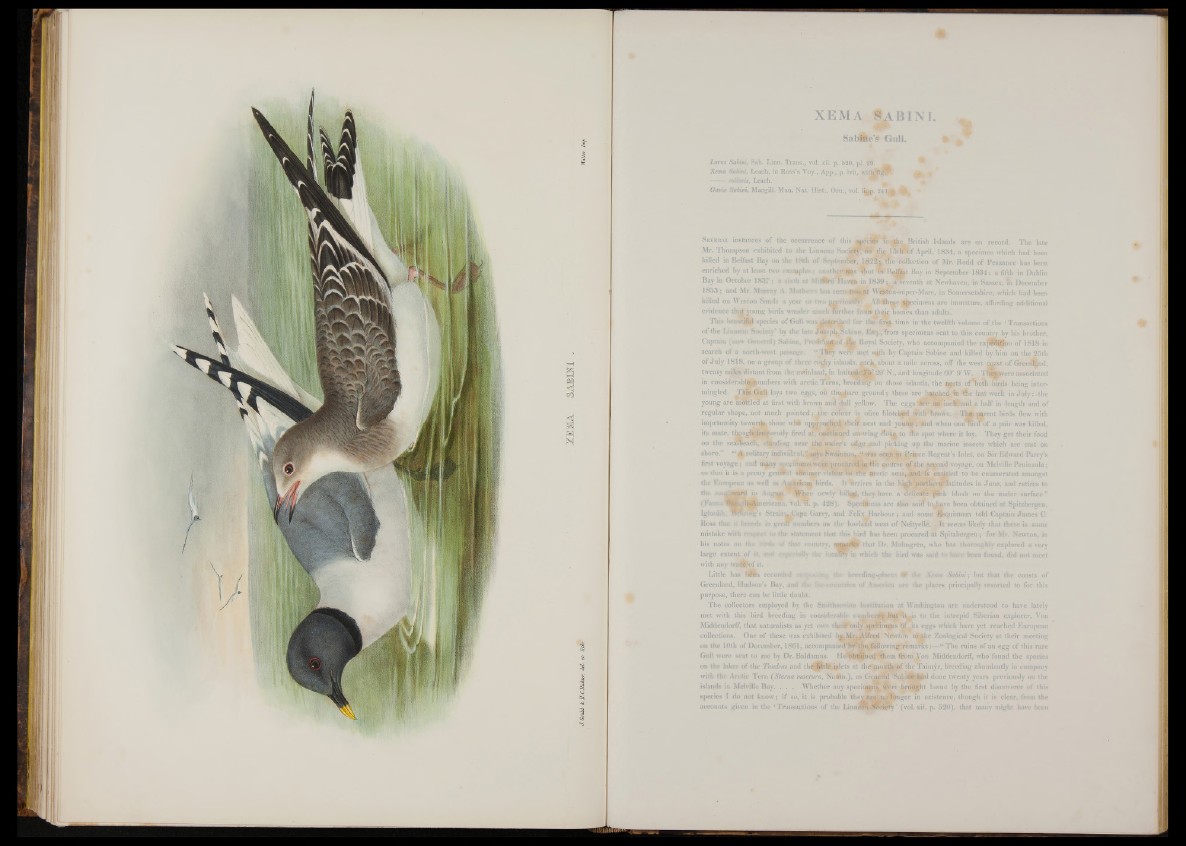
J GvuLd St U.C.
XEMA SABINI
Sabine’s Gull.
Lams Salmi, -Sab. Linn. Trans., vol. xii. p. 620, pi. 29. m
Xema Sakmi, Leach, in Ross’s Voy., App., p. lvii, withffi J P
catioris, Leach.
Gavia Sabini, Macgill. Man. Nat. Hist., Orn., vol. iaup. 241.-; ' •
S ev er a l instances of the occurrence o f this .s p e c ie s in .¿the British Islands are on record. The late
Mr. Thompson exhibited to the Linncim Society, oh tlie Îètiï' of April, 1834, a specimen which had been
killed in Belfast Bay on the 18th of September, collection of Mr. Rodd o f Penzance has been
enriched by at least two examples; .another shot in B.el£fjst Bay in September 1834; a fifth in Dublin
Bay in October 1837 ; a sixth at MiPfcd Haven in 1839 ; a^ v en tk at Newhaven, in Sussex, in December
1853; and Mr. Murray A. Mathers has seen two,.at Westôn-sûper-Mare, in Somersetshire, which had been
killed on Weston Sands a year or two mseviotmSFi AH thgge specimens are immature, affording additional
evidence that young birds wander much further from their nomes than adults.
This beatiliful species o f Gull wasdegcribed for the first time in the twelfth‘volume o f the ‘Transactions
o f the Linnean Society’ by the late Joseph, Sabine, Esq., from specimens sent to this country by his brother,
Captain (now Genera}) Sabine, Presideidpiof the Royal Society, who accompanied the expédition o f 1818 in
search o f a north-west passage. “ Tnery were met vvi,th by Captain Sabine and killed by him on the 25th
o f July 1818, on a group of three rocjcy islands, eaqj^ about a mile across, off the west c,oasfc o f Greedtund,
twenty miles distant from the mainland, in latitudc'7â?$9' N ., and longitude 60° O' W . Tbjey.were associated
in considerable numbers with arctic Terns, breeding on those islands, the nests o f both birds being intermingled.
This Gull lays two eggs, on theajjare ground; these are hatched in the last week in July: the
young are mottled at first with brown and dull yellow. The eggs are an inch; and a half in length and of
regular shape, not much pointed; the colour is olive blotched with brown. riWpa ren t birds flew with
impetuosity towards those who approached^ theff1 nest and young; and when one bird o f a pair was killed,
its mate, thoiigliifre<tuently fired at, continued on wing close, to the spot where it lay. They get their food
on the sea-Deacn, standing near the water’s edge .and picking up the marine insects which are cast on
shore.” “ A solitary individrrd,” says Swaiuson, “ was seen in Prince Regent’s Inlet, on Sir Edward Parry’s
first voyage ; and many sp-v'rmmswere procured in the course o f the second voyage, on Melville Peninsula ;
so that it is a pretty générai sSfnmer visitor to the Arctic seas, and is entitled to be enumerated amongst
the European as well as American birds. It Arrives in the high northertf latitudes in June, and retires to
the K*qjJp«Ard in Augugt. When newly kiH*$, they have a delicafe pink blush on the under surface”
(kauvï^lMMHMnericarta, vol. It. p. 428). Specimens are also said to ..have been obtained at Spitzbergen,
Igioofik, iBmrirtg’s Straits, Cape Garry, and Felix. Harbour ; aud some ¡Esquimaux told Captain James C.
Ross that tt breed* in great numbers on the lowland West of Neityellé. - It seems likely that there is some
mistake with rpvpevs to the statement that this bird has been procured at Spitzbergen ; for Mr. Newton, in
his notes on the b ird s o f that country, remarks that Dr. Mulmgren, who has thoroughly explored a very
large extent o f it, the locaïîiÿ in which the bird was said to have been found, did not meet
with any tgamppf it.
Little has been recorded <■■■-■ y ■. (fee breeding-jdaees 0 the Xema Sabini ; but that the coasts of
Greenland, Hudson’s Bay, and iW ^ u a ir ics of America arc the places principally resorted to for this
purpose, there can he little doubt.
The collectors employed by the Smithsonian Institution at Washington are understood to have lately
met with this bird breeding in considerable number**? hut it As to the intrepid Siberian explorer, Von
Middendorff, that naturalists as yet owe rif&ir only specimens pf its eggs which have yet reached European
collections. One o f these was exhibited by. Mr.,,.Alfred Newton to,tbe Zoological Society at their meeting
on the 10th o f December, 1861, accompanied by the, following remarks:—“ The ruins o f an egg o f this rare
Gull were sent to me, by Dr. Baldamus. He’Pbfcaiined them from Von Middendorff, who found the species
on the lakes of the Tundras and th sB t fê « lets at the. mouth of the Taimyr, breeding abundantly in company
with the Arctic Tern (Sterna macrura, Naum.), as General Sabine had done twenty years previously on the
islands in Melville Bay. . . . Whether any specimens were brought home by the first discoverer o f this
species I do not know ; if so, it is probable they are: no -longer in existence, though it is clear, from the
accounts given in the ‘Transactions o f the Linnean-Smeiely ’ (vol. xii. p. 520), that many might have been